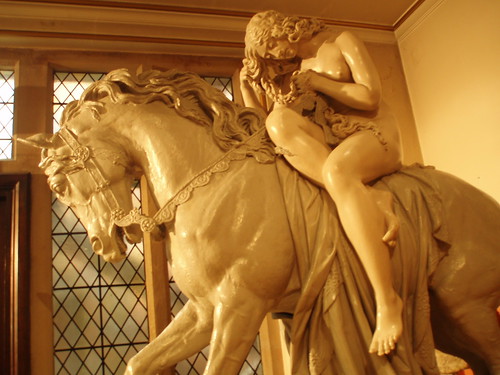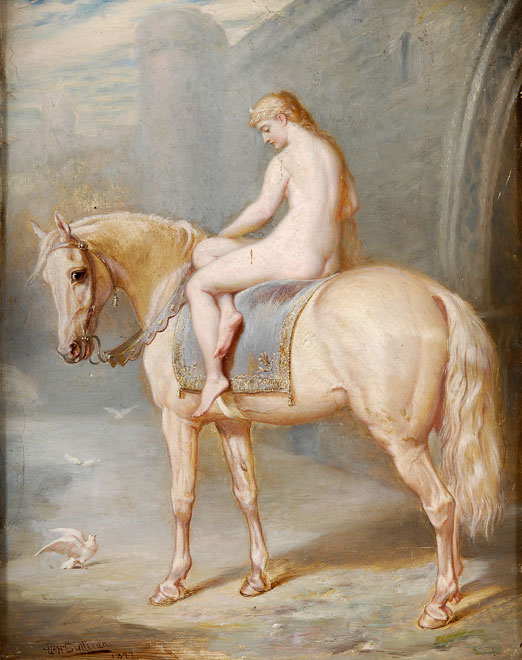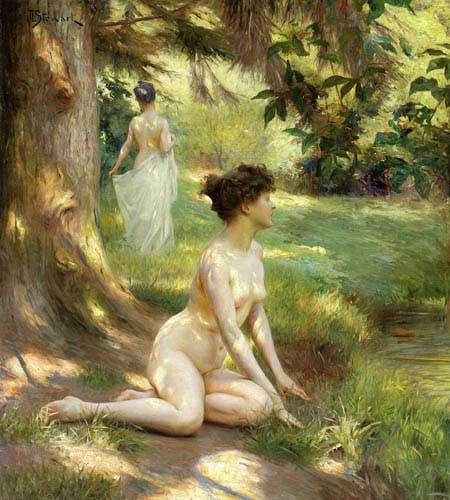.
 |
| 19th century Lady Godiva statue John Thomas,sculptor |
Lady Godiva or Godgifu was an English countess, who according to historians, flourished circa 1040-1080. She was the wife of Leofric,Earl of Mercia. The couple were noted for their great generosity to religious houses.In 1043 Leofric founded and endowed a Benedictine monastery at Coventry, to which Godiva persuaded Leofric to found the monastery her; and the endowment of the minister at Stow St. Mary, Lincolnshire. Lady Godiva and her husband are also commemorated as benefactors of other monasteries at Chester, Much Wenlock, and Evesham. The town of Coventry received from Lady Godiva, a number of works in precious metals that were made for this purpose and bequeathed a necklace valued at 100 marks of silver. Evesham received another necklace, to be hung around the figure of the Virgin Mary accompanying the life -size gold and silver rood* and St. Paul's Cathedral, London received a a gold - fringed chasuble*. She and her husband were among the most munificent* of several large Anglo-Saxon donors of the last decade before the Norman Conquest; the Norman bishops made short work of their gifts, either carrying them off to Normandy or melting them down for bullion.
The manor of Woolhope in Herfordshire, along with 4 others, was given to the cathedral at Herefordshire before the Norman Conquest by Godiva and Wulviva ( said to be Godiva's sister). The church has a 20th century stained glass window representing them.
Lady Godiva's mark, di Ego Godiva Comitissa diu istud desideravi, appears on charter that was supposedly given to her by Thorold of Bucknall to the Benedictine monastery of Spalding. The charter is considered to be a fake by many historians. Even so, it is possible for Thorold to be Lady Godiva's brother.
After the death of her husband in 1057, Godiva lived on until sometime between the Norman Conquest an 1080. She is mentioned in the Doomsday survey* as one of the few Anglo-Saxons and the only woman to remain a major landholder shortly after the Conquest. By the time of this survey, in 1086, Godiva had died, but what had been her lands are still listed, but now held by others.
Lady Godiva's burial spot is a matter of debate. The Chronicon Abbatiae de Evesham or the Chronicles of Evesham,say that she is buried the Church of the Blessed Trinity at Evesham, which is no longer standing. But according to the Oxford Dictionary of National Biography Lady Godiva is buried by Leofric in Coventry, no matter what the Evesham Chronicles say.
 |
| Lady Godiva statue, Sir William Reid Dick, 1949 |
Lady Godiva is known to popular legend, she obtained a reduction in the excessive taxes levied by her husband on the people of Coventry, by consenting to ride through town naked on a white horse. The townspeople were to stay inside and shut there windows while she to look at her ride, clothed only in her long hair. But while she was on her legendary ride, one townsman, a tailor, disobeyed her proclamation and looks, forever being known as Peeping Tom. In the end Lady Godiva's husband keeps his word and does away with the required taxation of the people of Coventry.
 |
| Lady Godiva by John Collier, ca 1897 |
|
*ROOD- crucifix
* CHASUBLE - outermost liturgical vestment worn by clergy for the celebration of the Eucharist.
*MUNIFICENT- very liberal in giving or bestowing
*DOOMSDAY SURVEY- record of the great survey of much of England and parts of Wales completed in 1086.
 |
| Lady Godiva by William Holmes Sullivan 1877 |













